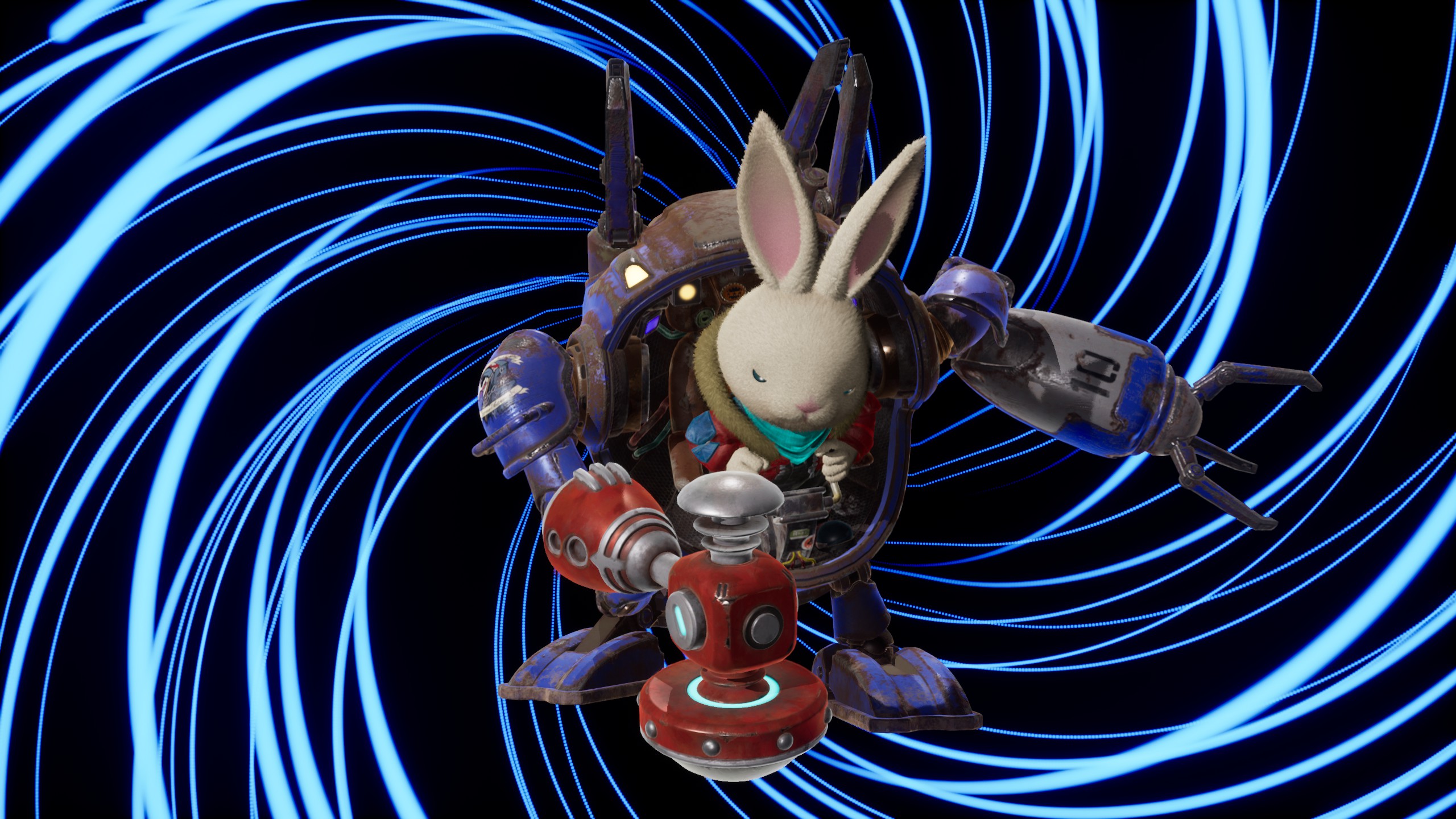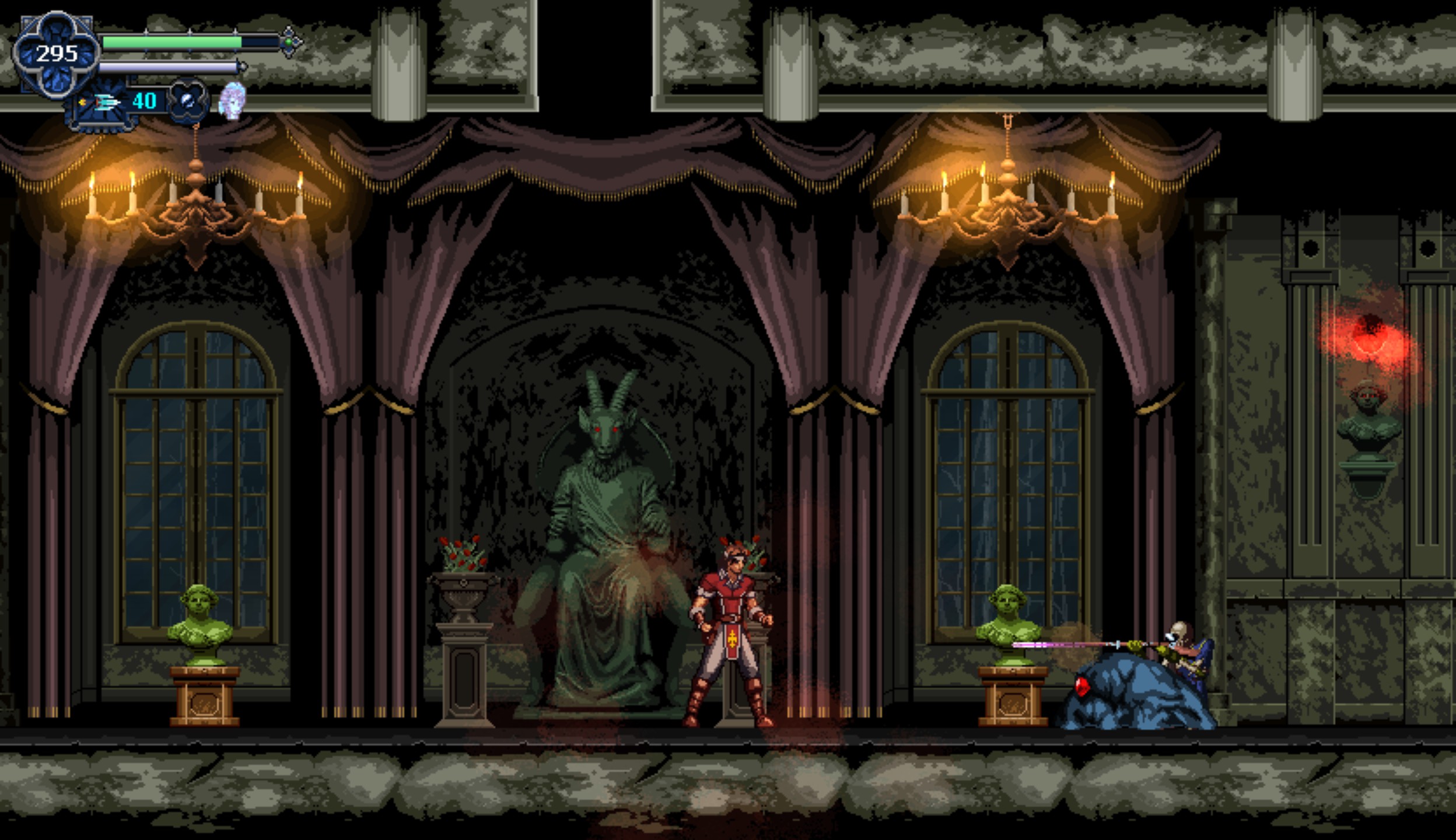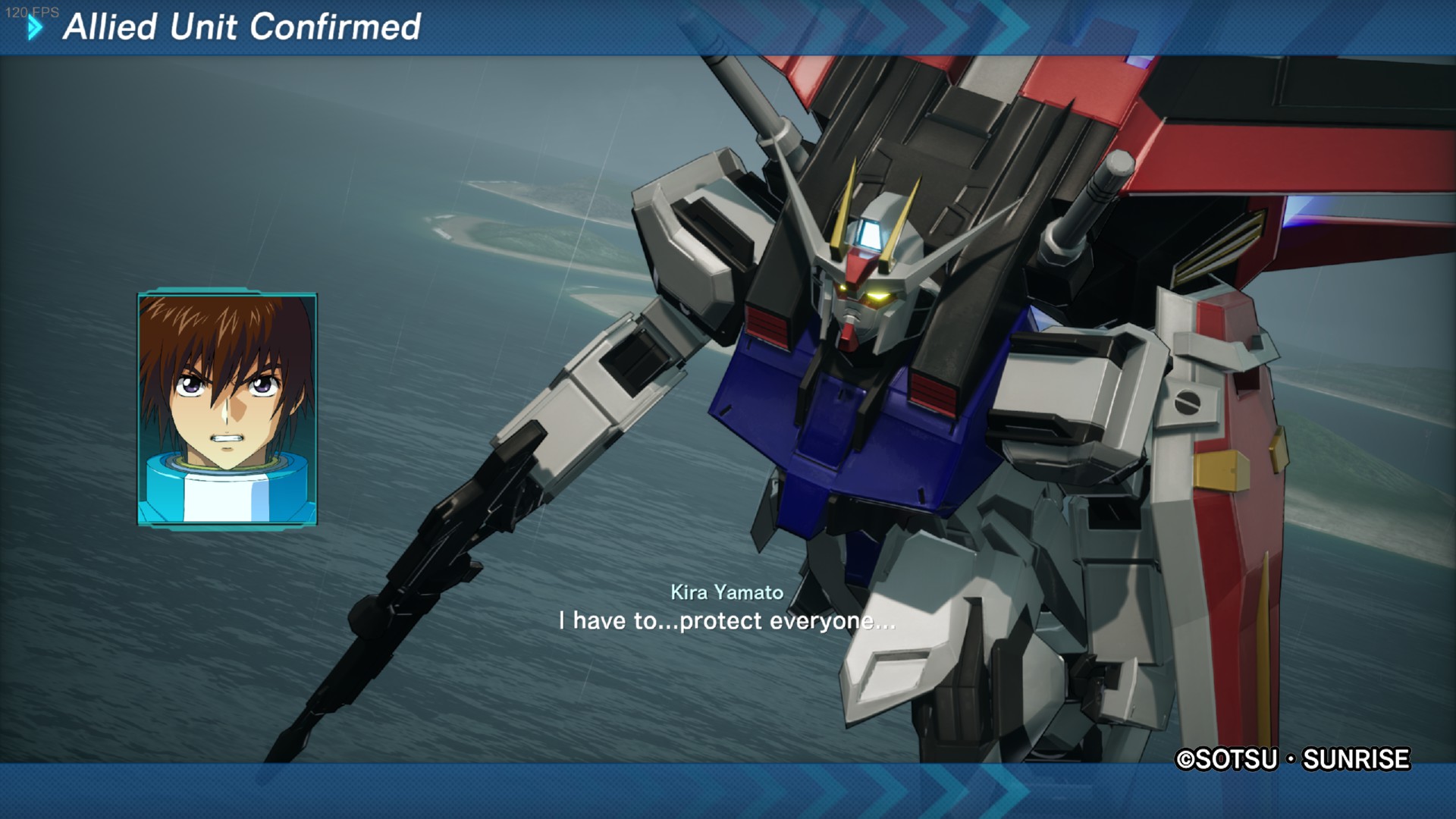Gen Urobuchi is famous for writing visual novels, books, and anime, but he’d never written a game before. Enter Rusty Rabbit, a game he made with visual novel developer, Nitroplus. On one hand, the game is large, has a surprising amount to it, and features a hell of a lot of text from the author. On the other, the controls are wonky, unreliable and several aspects of the game’s design are haphazard and lead to a less-than-pleasant gaming experience. I kind of liked it overall, but I simply can’t overlook the game’s baffling design decisions.
Rusty Rabbit is about a rabbit called Rusty Stamp (go figure.) Years after his wife died and his daughter left town to go on an archaeology dig, Stamp, a “rust-grubber” that goes hunting for junk, heads deeper into Smokestack Mountain, a location that hides treasures untold and long-buried secrets. The plot works for a game like this, but it has surprisingly little narrative momentum. Stamp explores and keeps running into a team of other rabbits surveying the area for a benefactor, but none of them actually matter in the long run. I could sum up the game’s plot in a matter of sentences.
There’s nothing wrong with that in a 2D platformer, of course, but there’s so much text and dialogue in Rusty Rabbit that it’s shocking to me that so little of its content matters. The cutscenes go nowhere, Stamp himself is a repetitive grouch, and so much of the side content is predicated on reading some of the most boring flavour text imaginable. A lot of it is either having a bunch of incredibly mundane conversations with the townsfolk to get items from them or reading hundreds of pages of text (no exaggeration) about fictional vehicles Stamp is repairing. I’m not sure who would care enough to read any of this and I’m even less sure why anyone thought it needed to be in this sort of game to begin with.
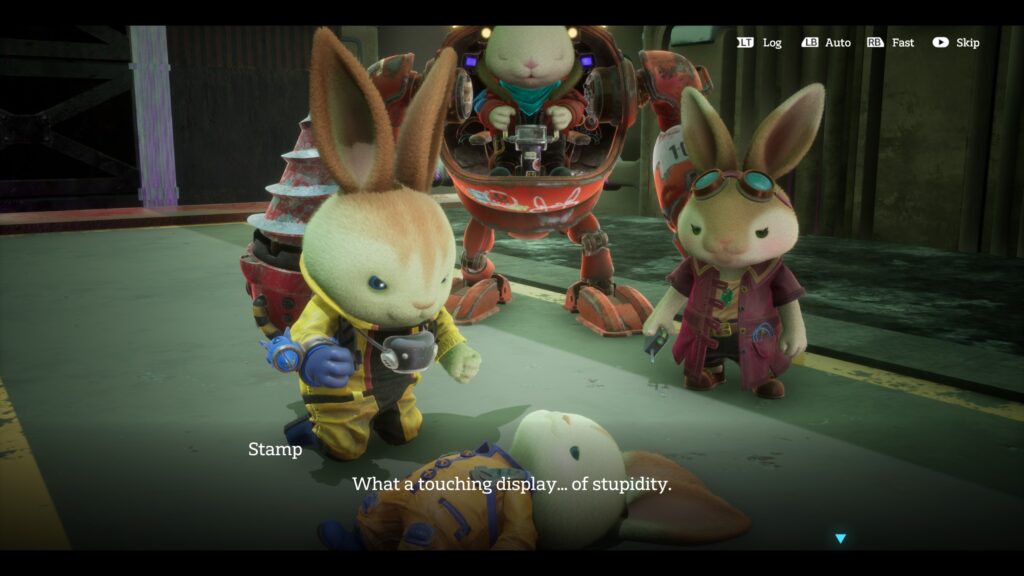
Rusty Rabbit posits itself as a sort of Metroidvania, but only technically. You mostly go through linear areas to reach a teleporter and travel to the next area. On rare occasions (literally one or two instances,) you’ll find a keycard in one area that opens a door in another one. You’ll be finding a lot of keycards and pulling a lot of levers, so the level design isn’t particularly imaginative. Granted, the game isn’t necessarily boring, but most of the levels do feel pretty samey, even though that’s rarely broken up by something else (one level has box puzzles, another has you pulling levers to rotate doors.)
Stamp pilots a mech that, in classic Metroidvania fashion, has extra functions at the start that you’ll lose access to once the mech gets damaged early on. You’ll get new parts and blueprints that restore the lost functionality, although most of the major ones are given by other characters during the game’s fully voiced cutscenes. One of Rusty Rabbit‘s biggest problems is that the controls just simply aren’t up to the task. Control of the mech is rigid and oftentimes inexact. A lot of the time, I felt like I was struggling to properly control it, to my great annoyance.
This is compounded by the fact that the game’s collision detection is sloppy. The mech has trouble landing on the edges of platforms. It’s common to land on one, only to slip off shortly after. You can end up getting stunlocked by landing on top of enemies as well, as you’ll awkwardly kind of hover around them, while repeatedly taking damage due to how poor the collision detection is.
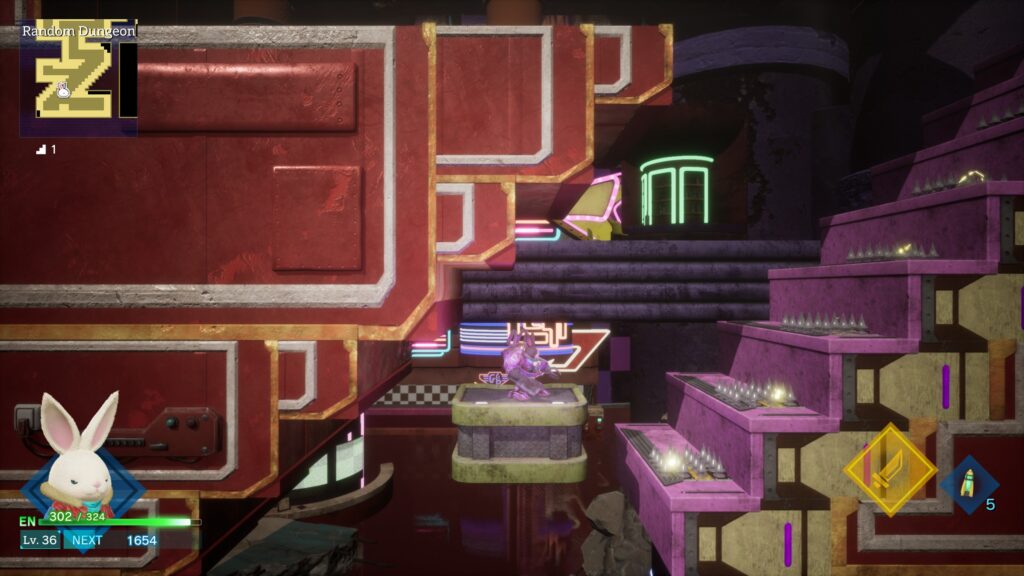
I had input issues on occasion, too. I’d try to do something, only for it to not register, even for something as simple as an attack. There are also issues with the game’s physics, as sometimes your mech will just kind of magically teleport around, since the physics don’t appear to have been properly coded. But this is mostly noticeable in the boss fights.
There are a good number of these, but they’re mostly subpar. Some of them are horribly unbalanced. The chameleon boss is easily the hardest boss in the game, despite there being multiple boss fights after that point. For whatever reason, the balancing on its health is off, so it takes way too long to whittle it down. Rusty Rabbit also has several status ailments, some of which last 30 entire seconds if you don’t have any skills or accessories to reduce their duration. Some of the bosses even use them. A boss being able to halve your damage for 30 seconds with its attacks was such a harebrained decision (pun very much intended.)
Enemies tend to overuse these status ailments too. One of them slows you down, while making it so you can’t dash or use your thrusters (and you get hit by this if you fall too far.) The last thing this game needed was to make controlling it that much more of a chore. You also get four different weapon types to swap between. Each enemy is weak to a specific weapon type and you’ll need to use these weapons to break barriers that only they can destroy. The drill can drill through blocks, the sword cuts plant matter or wires, the hammer breaks blocks or damaged walls.
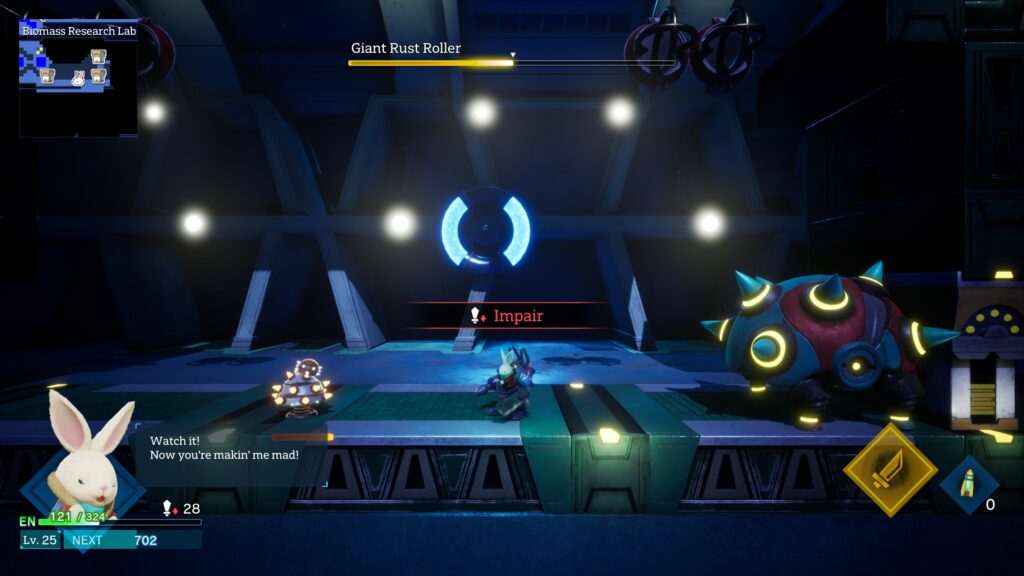
You even get guns, which is the best weapon type because the others are all more cumbersome. The combat in Rusty Rabbit is just as middling as the platforming. Your character just doesn’t move well and the range of your attacks often doesn’t feel satisfactory. Combine that with the janky collision detection and it’s a recipe for a poor time. While exploring, you’ll constantly find cubes to drill (some of which grant you materials) and you’ll use materials you’ve found to craft new weapons. However, this leads to another one of the game’s biggest head-scratching design decisions.
Each of the four weapon varieties has five types. You’ll unlock most of these by finding blueprints, many of which require you to backtrack and use your weapons to break obstacles after crafting a weapon that can destroy them. It’s very easy to go the entire game without finding enough blueprints to craft new weapons, though. When I beat the game, I had a mid-level drill and hammer (which the game outright gives you the blueprints for,) but I was still using the starter gun and sword. Unfortunately for me, most of the areas I couldn’t reach in earlier levels were locked behind objects that only an upgraded sword could cut.
I scoured the game to the best of my ability to find the missing sword blueprint I needed. I eventually found the blueprint for the drill that would let me break a few more blocks that likely prevented me from finding the sword blueprint, but when I went to craft the drill I was told I was missing a crafting material. A crafting material that I’d never even seen before, despite having beaten the game and opened almost every material container in it. What a dreadful decision.

Nothing in the game told me where to get this component, so I was just out of luck. This is absolutely terrible design. Almost all of the game’s Metroidvania leanings are built around this broken loop, so most will just play it linearly. Why block the areas off if you’re going to do such a sloppy job of letting players actually access them?
At another point, you need to upgrade your drill to proceed, but one of the necessary crafting materials was rare, so I had no choice but to go in and grind two specific levels of the game’s random dungeons. This required me to start a level and then return to the village via the menu if it didn’t take me to one of the two levels that spawned the material. I’m not sure why Nitroplus was so insistent on doing things like this, but it took a game with problems and made them worse. Granted, this only happened a single time for the mandatory story content, but it stuck out like a sore thumb.
With some additional polishing for the controls, gameplay, physics, balance, and ease-of-use in finding materials and missing blueprints, Rusty Rabbit would have been a lot better. Instead, it’s a fairly clumsy game that makes many ill-advised, contradictory choices while drowning the player in pointless text. The 20ish hours it took to beat the game weren’t really worth it in the end, but I hope some patches even the game out. Without them, though, there’s not much reason to dig into this one unless you just really want to hear the Japanese VA for Kiryu voice an anthropomorphic rabbit.

Rusty Rabbit: From a lacklustre concept to a game with a lot of issues, Rusty Rabbit does have its bright spots, but the rest of the game can make getting to them a bit of a chore. – Andrew Farrell
Take a look at our previous review:
The Talos Principle: Reawakened PC review — A solid remaster of a game that really didn’t need one |

